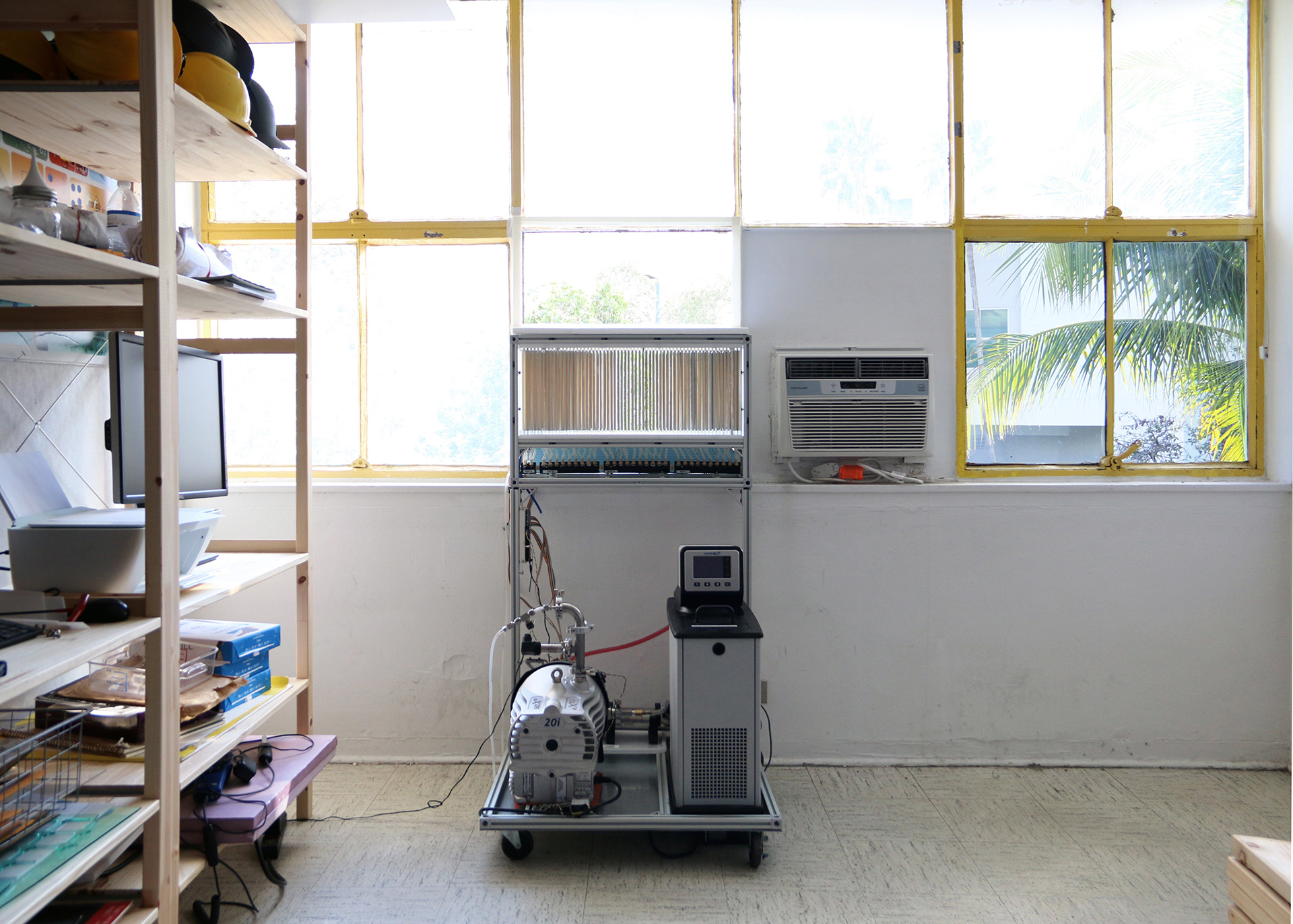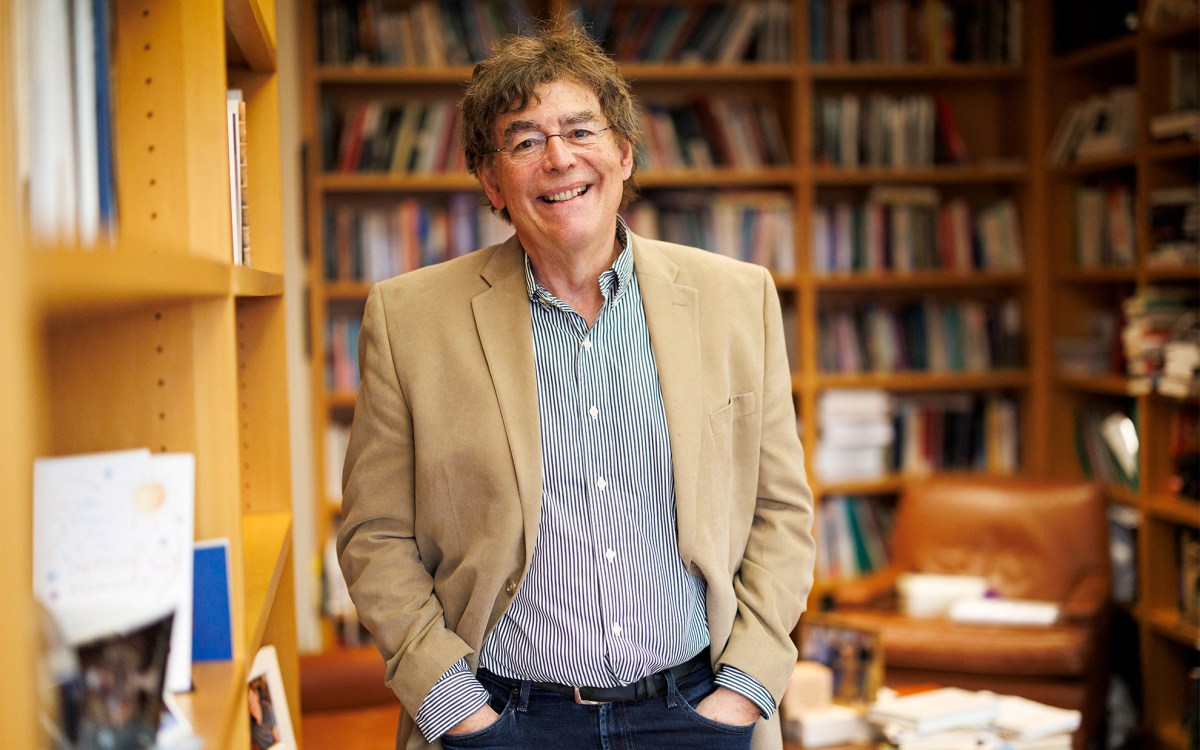
Researcher Peteris Lazovskis holds a Trellis Air membrane.
AC use to surge as world gets hotter. Harvard startup has a solution.
Novel system works like a coffee filter to dry, cool air more efficiently
Today, systems that cool buildings account for as much as 4 percent of global greenhouse gas emissions. That may seem like a small fraction, but it’s significant: double the emissions associated with all air travel, for example.
As the world gets hotter due to climate change, the need for cooling is set to rise substantially. Air conditioning demand is expected to soar by up to 40 percent by 2030. Energy use, and the associated climate-warming emissions, will balloon along with it.
“There’s a climate-change solution here,” said Jonathan Grinham, assistant professor of architecture at Harvard’s Graduate School of Design. “The problem is big, and the market opportunity is big.”
Despite the revolution coming for demand, the technology used to cool spaces has remained relatively stagnant for more than a century. “We’ve lived in the status quo of the bigger industries delivering the same vapor-compression technology,” said Grinham.
Trellis Air, a Harvard startup, is set to disrupt that status quo. Thanks to collaborative efforts from across the University, the company recently launched with aims to drastically reduce the energy needed to run air conditioners with its novel approach to dehumidification.
‘Marriage of raw science and engineering breakthroughs’
Most air conditioners are not all that different from souped-up dehumidifiers. A cooling system pulls in room-temperature air and chills it using chemicals called refrigerants. Water vapor separated from the air is condensed — resulting in that “drip, drip, drip” that air conditioners are notorious for — while the cooler air is released into a room and heat is diverted outside.
Air-conditioning technology also makes air drier, and dehumidifiers use a similar process to condense water out of ambient air. The cool, dry air is then rewarmed and released back into the room.
“A dehumidifier burns a lot of energy,” said Russ Wilcox, Trellis Air CEO. “It’s like driving with one foot on the gas, the other foot on the brake: You’ve got one part making cold, the other part making heat.”
While refrigerants — which have significant planet-warming potential of their own — are at the core of most modern cooling systems, some industrial facilities that need incredibly dry air may also choose what’s called a desiccant air dryer, a system that uses a material like salt to absorb water.
Trellis Air, on the other hand, will rely on a “third way,” of pulling moisture from the air, said Wilcox. Harvard scientists developed a unique membrane capable of separating water vapor directly from the air — similar to a coffee filter. The system uses much less energy than traditional air conditioners and dehumidifiers and is more stable than desiccant systems.

To develop the underlying tech, Grinham worked closely with staff scientist Jack Alvarenga and others in the lab of Joanna Aizenberg, the Amy Smith Berylson Professor of Materials Science at Harvard’s John A. Paulson School of Engineering and Applied Sciences (SEAS) and professor of chemistry and chemical biology at Harvard. Leveraging his deep expertise in architecture and building science, Grinham collaborated with Alvarenga and other researchers in the Aizenberg Lab to prototype materials and conduct the foundational science needed to create Trellis Air’s product.
The Wyss Institute for Biologically Inspired Engineering supported the team’s initial research on building cooling technology, which helped in the discovery phase. This funding, along with funding from Harvard’s Office of the Vice Provost for Climate and Sustainability and the U.S. Department of Energy, allowed Grinham, Alvarenga, and the team at SEAS to develop a new technology and then reach out to Harvard’s Office of Technology Development (OTD) to assist the innovation on the pathway to commercialization.
Membrane dehumidification systems have been attempted in the past, but struggled to achieve high-water selectivity with scalable and robust materials. In addition to developing a workable membrane, the Harvard team designed a novel, 3D-printed tile assembly that allows water to readily pass through while protecting the delicate membrane, which is just 15 microns thick — thinner than a human hair — for long periods of time.
“It was this really nice marriage of raw science and engineering breakthroughs,” said Christopher Petty, OTD’s director of business development for physical sciences.
‘If he says something is worth seeing, it’s usually worth seeing’
OTD protected the intellectual property of the innovations developed at Harvard and licensed it to Trellis Air for further development. Grinham and Alvarenga will stay involved as scientific advisers to the company, as will Aizenberg and Martin Bechthold from the School of Design.
Petty, a former entrepreneur himself, wasn’t initially familiar with the type of tech Grinham and the research team set out to develop. But what he learned about the scope of the air conditioning challenge stunned him, and convinced him of the business’s potential.
“Sometimes it’s enough that it’s a good business, it has to be,” says Petty. “But if you feel you can work on something that might have that kind of impact, then it helps you sleep at night too.”
He began networking to find an entrepreneur who could shepherd the idea from technological breakthrough to big-time business.
Wilcox, an entrepreneur turned venture capitalist who had previously popularized the electronic paper-display technology that’s today used in millions of Kindles, was among Petty’s early calls. And his interest was immediately piqued. “If he says something is worth seeing, it’s usually worth seeing,” says Wilcox.
Still, it took more than a dozen meetings before Wilcox decided to become the company’s CEO. Wilcox was convinced from the beginning that the opportunity was a huge one, due to the sheer size of the AC industry, but he decided to make the jump after learning that several past colleagues from his former company, E Ink, were willing to sign on with him.
Starting a company that he believed in with past coworkers “just seemed like the most joyful thing I could do,” he said. “Nothing could be more exciting.”
Wilcox sees three roads to commercialization for Trellis Air: replacing desiccant systems in industrial applications, swapping basement dehumidifiers for more efficient models, and the big-time bet: integrating Trellis Air’s technology with air conditioners across the world. Wilcox says the company will pitch the tech as a “pre-drying module” that will allow ACs to run much more efficiently, consuming much less energy.
The CEO has backed nearly two dozen companies as an investor, and sees big possibilities for Trellis Air, in part because of the huge potential reward. “In order for a deep-tech startup to work, you need a big, bold goal that everyone will decide is worth the risk,” he said. The scope of the air conditioning challenge fits the bill.
To de-risk the tech and show that it can work, Trellis Air has spent the past year prototyping. Before the company launched, a proof-of-concept prototype was piloted in Miami through the team’s Department of Energy Grant with Forrest Meggers at Princeton University and Les Norford at MIT. Next, the team tested a fully integrated system at Harvard’s HouseZero, the headquarters of the Harvard Center for Green Buildings and Cities, retrofitted as a “living lab” to test and collect data on the technology’s efficiency in a real-world setting. These demonstrations showed what Trellis Air’s tech can do in Boston’s hot, humid summers and the even more inhospitable Miami climate.
Those real-world examples should help give funders confidence in the system’s capabilities.
“It’s one thing to build energy models to say that this is possible, and it’s a whole other thing to actually deliver the physical prototype at scale,” said Alvarenga. “We were able to bring the idea into existence inside the lab and then move beyond the lab into pilot field studies. With Trellis Air we want to go further and scale up a commercial product that can meaningfully reduce the future massive energy and emissions needs of cooling.”
Harvard IP licensed to Trellis Air was funded in part by the Department of Energy and National Science Foundation.





